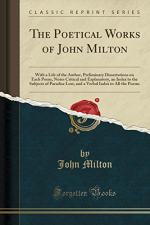|
This section contains 836 words (approx. 3 pages at 400 words per page) |

|
Darkness and Light
One of the principle motifs in the poem is the contrast between darkness and light. Throughout the first half of the poem, Milton uses the images of light and darkness frequently. Light is associated with goodness, but also with sacredness and vitality, while darkness is associated with evil. The speaker mourns that “[his] light is spent,” likely referring to the fact that he is no longer able to see (1). He now inhabits, very literally, “this dark world” — dark because of his blindness, but also because of his sense of despair (2). Without the ability to see the difference between light and darkness, he worries that spiritual light will be “denied” him (7). This configuration poses light and dark as being opposing forces, opposites that can never coexist.
Here, Milton relies on a common literary trope of his era, celebrating lightness and condemning or warning against darkness...
|
This section contains 836 words (approx. 3 pages at 400 words per page) |

|




